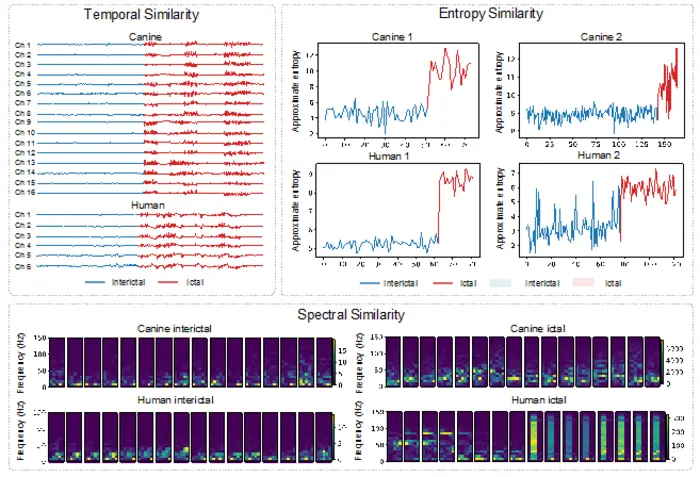A groundbreaking study led by Professor Dongrui Wu at the Huazhong University of Science and Technology highlights the promising potential of using cross-species and cross-modality data to enhance the detection of epileptic seizures. The research focuses on harnessing the similarities in electroencephalography (EEG) features between dogs and humans, paving the way for advancements in real-time seizure classification. This innovative approach not only addresses the challenges associated with a lack of labeled data in target species but also demonstrates the feasibility of leveraging existing data from auxiliary species.
The central theme of this research revolves around the analysis of various features from EEG signals, including temporal, spectral, and entropy characteristics. By investigating these features as they correspond across canine and human subjects, the study reveals insightful correlations. It is noted that during epileptic seizures, both canines and humans exhibit significant fluctuations in their EEG signals, reinforcing the notion that time-domain features can be effectively transferred between species. This similarity offers a robust foundation for implementing machine learning algorithms capable of detecting seizure patterns with higher accuracy.
Another critical finding of the study pertains to the concept of entropy, a measure that captures the unpredictability of a system. The analysis shows that approximate entropy values from both canines and humans increase notably during seizure episodes. This rise underscores the transferability of entropy features, showcasing how computational models can be enriched by utilizing EEG data derived from different species. By integrating these features, researchers can improve the sensitivity and specificity of seizure detection systems, ultimately benefiting patients with epilepsy.
Furthermore, the research delves into spectral features, represented through the power spectral density spectrograms obtained from consecutive Fourier transforms. The findings indicate a significant increase in power across all channels of EEG signals from both canines and humans during seizures. This elevation further supports the hypothesis that frequency-domain features are transferable, highlighting the potential to develop a unified model that leverages data from both species to improve overall performance in seizure classification tasks.
Despite the promising results, the study acknowledges the inherent challenges tied to discrepancies between species and modalities. These obstacles primarily stem from variations in electrode configurations, data acquisition methods, and signal characteristics. Notably, canines require implanted intracranial electrodes for data collection, while humans typically utilize non-invasive scalp electrodes. Such differences complicate the alignment of EEG data across species and modalities, necessitating innovative approaches to data harmonization.
Moreover, the study reveals significant disparities in electrode counts and configurations, which further exacerbate the challenges facing researchers. For instance, canines had 16 intracranial electrodes, while only six electrodes were used for human scalp EEG data. Such discrepancies highlight the need to develop robust methodologies that can effectively bridge the input space gaps and ensure a comprehensive understanding of EEG signal characteristics across species.
The research team emphasizes the importance of addressing not only the input space contradictions but also the distribution discrepancies inherent in the feature and output spaces. The limited availability of labeled data for the target species poses yet another critical obstacle in the realm of automatic seizure detection. This limitation necessitates the integration of auxiliary labeled data from alternative species or modalities to train more effective seizure classifiers.
To tackle these challenges head-on, the study proposes a multi-faceted approach, which includes Euclidean alignment to mitigate input space discrepancies, domain adaptation techniques for feature space distribution alignment, and knowledge distillation methods to benefit output space alignment. By implementing these strategies, the research demonstrates the feasibility of employing a joint alignment mechanism across input, feature, and output spaces, facilitating the transfer of seizure patterns across species.
Throughout the pilot study, the researchers collected rich data sets, enabling them to fine-tune their algorithms and models effectively. The integration of multi-species and multi-modality data not only improves the classifier performance but also contributes to a deeper understanding of EEG signal dynamics across different biological contexts. This endeavor opens the door to a myriad of possibilities in the realm of epilepsy research, shedding light on the collaborative potential that exists within the field.
Furthermore, this pioneering research sets the stage for future investigations that could expand the toolbox of methods available for seizure detection. As we continue to face the common limitation of insufficient labeled data in the field, the study highlights the pressing need for innovative solutions that leverage existing resources. By analyzing EEG data from various biological systems, researchers can devise comprehensive models that are capable of grasping complex seizure patterns, ultimately leading to enhanced clinical applications.
The implications of this study extend far beyond the laboratory. The potential use of cross-species data could accelerate the development of advanced seizure detection technologies that improve patient care. This convergence of data from different species signifies a paradigm shift wherein researchers can draw insights from a broader pool of information, enriching our understanding of neurological disorders and enhancing treatment methodologies.
In conclusion, the insights garnered from this research reinforce the notion that cross-species collaboration has the power to drive significant advancements in our understanding of epilepsy. By embracing the complexities of multi-species and multi-modality integration, the scientific community stands to benefit from a wealth of knowledge that can ultimately contribute to better outcomes for patients affected by seizures.
Subject of Research: Cross-species and cross-modality epileptic seizure detection
Article Title: Canine EEG helps human: cross-species and cross-modality epileptic seizure detection via multi-space alignment
News Publication Date: [Specific date not provided]
Web References: [Specific references not provided]
References: [Specific references not provided]
Image Credits: ©Science China Press
Keywords: EEG, seizures, cross-species, canine, human, temporal features, spectral features, entropy features, epilepsy detection, data transferability, feature alignment.




